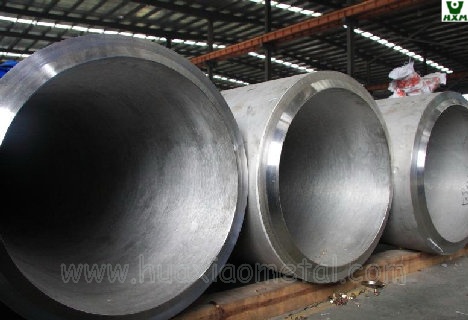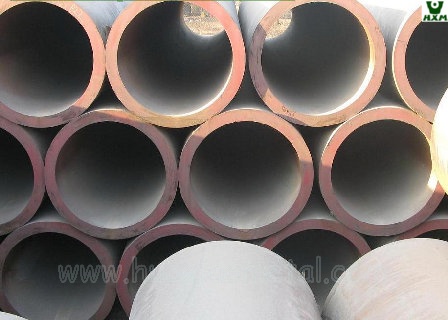Alloy Steel Pipe EN10216-2 Suppliers | Manufacturers
EN 10216-2 alloy steel pipe is a seamless steel pipe designed for high-temperature and high-pressure conditions. It is widely used in industrial fields such as boilers, pipelines, and heat exchangers. Huaxiao Metal has a rich stock of EN 10216-2 alloy steel pipes, providing a variety of grades such as P235GH, P265GH, 16Mo3, and 10CrMo9-10 to meet customers’ needs for different specifications and wall thicknesses. As an experienced supplier, we are committed to providing customers with quality products and competitive prices.


- OD: 10.2mm-720mm
- WT: 1.2mm~12mm
- Length: 5-12m or as to customer requirement
- Surface: Painting, oil coating, Anti-corrosion & Insulation.
- Delivery state: Hot Rolled, Cold Drawn.
- Steel Grade: P195GH, P235GH, P265GH, 16Mo3, 14MoV6-3, 13CrMo4-5, 10CrMo9-10, etc.
Alloy Steel Pipe EN10216-2 Grade Available Specification
If you want to learn more, please free to contact us and request a free sample and quote, etc.
| Product Name | Executive Standard | Dimension (mm) | Steel Code / Steel Grade |
| Seamless Ferritic Alloy Steel Pipes for High Temperature Use | EN10216-2 | Ø8″~42″ x WT15~100 | 13CrMo4-5, 1-CrMo9-10, X10CrMoVNb9-1, 15NiCuMoNb5-6-4 |
Product Scope:
EN10216-2 is a specification for seamless steel pipes for specific high temperature applications such as boiler tubes and power plants. It has the following steel grades: P195GH, P235GH, P265GH, 16Mo3, 14MoV6-3, 13CrMo4-5, 10CrMo9-10, including non Alloy and alloy steel. EN 10216-2 specifies the technical delivery conditions for 2 test categories for circular section seamless pipes, ANSON is an experienced supplier of boiler and pressure steel pipes that can supply you with EN10216-2 pipes in all grades and size ranges .
Inspection and Test For EN 10216-2 Alloy Steel Pipe
| Inspection and test type | Test frequency | Test category | ||
|---|---|---|---|---|
| Mandatory tests | Ladle analysis | One per ladle | 1 | 2 |
| Tensile testing in room temperature | One per every test pipe | X | X | |
| Flattening test for D<600mm and the ratio of D≤0.15 but T≤40mm or ring testing for D>150mm and T ≤40mm | X | X | ||
| Rolling test on a mandrel bar for D≤150mm and T≤10mm or ring testing for D≤114,3mm and T ≤12,5mm | X | X | ||
| Resilience testing at the temperature of 20 ºC | X | X | ||
| Tightness testing | Every pipe | X | X | |
| Dimensional testing | X | X | ||
| Visual inspection | X | X | ||
| NDT in order to identify longitudinal discontinuity | Every pipe | X | X | |
| Material identification for alloy steel | X | X | ||
| Optional tests | Final product analysis | One per ladle | X | X |
| Tensile testing at elevated temperature | One per ladle and for the same thermal processing conditions | X | X | |
| Resilience testing | One per every test pipe | X | X | |
| Resilience testing in the machine direction at the temperature of -10ºC for non-alloy steel grades | X | X | ||
| Wall thickness measurement at a distance from pipe ends | X | X | ||
| NDT in order to identify transverse discontinuity | Every pipe | X | X | |
| NDT in order to identify delamination | X | X | ||
FAQ
What is EN 10216-2 material?
EN 10216-2 is a European standard for seamless steel tubes, mainly for pressure applications at elevated temperatures. The materials covered by this standard are mainly alloy and non-alloy steels, which have good heat and temperature resistance and are commonly used in equipment such as boilers, pipelines and heat exchangers. Common steel grades for EN 10216-2 include P235GH, P265GH, 16Mo3 and 10CrMo9-10, which vary in chemical composition and mechanical properties depending on the specific application requirements.
What is the ASTM code for alloy steel pipe?
In the American ASTM specification, the common standard for alloy steel seamless pipes is ASTM A335, which covers a variety of ferritic alloy steel pipes for high-temperature applications. Common steel grades include P5, P9, P11, P22, P91, etc.
What is the wall thickness of en 10216-2?
The EN 10216-2 standard has a wide range of wall thicknesses, depending on the specific application and the outer diameter of the pipe, generally ranging from a few millimeters to tens of millimeters, suitable for use under different pressure and temperature conditions.



